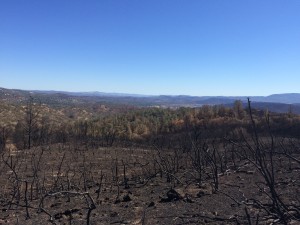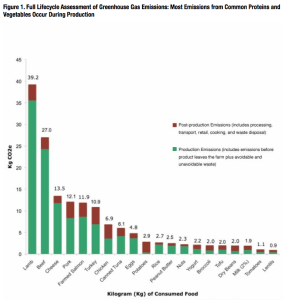Burning Dinner: Reflections on the Valley Fire
Dr. Will Tuttle
On a recent Saturday afternoon here in Hidden Valley Lake in northern California’s Lake county, Madeleine and I both noticed the telltale smell of smoke. It was an unusually windy day, and from our ridge-top home, about an hour north of both Napa and Santa Rosa, we could suddenly see smoke in the forested hills to the southwest, coming from the direction of nearby Middletown. We had just returned the day before from a month-long stay in Europe, and I was about to head up to Clearlake, about fifteen minutes north, to get our car battery tested. We’d had two major wild land fires in our region earlier in the summer, but unlike those, this one seemed to be moving in our direction.
As I drove north along Highway 29, a two-lane road in this hilly and rural area, enormous thick clouds of smoke rolled ominously to my left above the forest, all the way to Clearlake. After cutting short the battery test as high winds swirled and massive clouds of smoke loomed above Clearlake, I was driving back home to Hidden Valley Lake when a speeding police car passed me. A few minutes later, approaching the turnoff to Hidden Valley, the traffic was stopped by this same car, which was turned sideways blocking the road, and though I didn’t realize it, Highway 29, the only traffic artery in southern Lake county, would remain closed for the next seven days as the fire raged and jumped the road in multiple places. I was able to get home and witness the panicked traffic jam as the mandatory evacuation orders of Hidden Valley’s six thousand people propelled everyone to head north up to Clearlake.
When I got back, Madeleine and I took some time to overview the situation below and around us, and could see the fires and smoke approaching from both the south and the west. As dusk gave way to night, we could see flames spreading along both near and distant hills. From our vantage point above the lake and most of the community, we could see the flames approaching a section of houses on the other side of the lake, and over the next few hours we witnessed from afar about eight homes engulfed and destroyed by flames. We also saw the flames coming ever closer on the other side of Highway 29, which runs in the valley below our house.
Eight days later, when the evacuation orders were lifted, and all the residents were allowed to repopulate our community, there were many powerful emotions, as some people had lost virtually everything. About seventy of the 2,400 homes in Hidden Valley Lake were destroyed by the Valley Fire. Other nearby communities were much more seriously devastated. Five people were killed in the fire, and about 1,500 homes were destroyed, including most of Anderson Springs, Harbin Hot Springs, Cobb, and Loch Lomond. The Valley Fire also burned over 70,000 acres of forest and chaparral, killing and displacing
Loch Lomond. The Valley Fire also burned over 70,000 acres of forest and chaparral, killing and displacing
countless animals.
The questions that arise for everyone revolve around the future: what will come next? Environmental researchers have recently confirmed that in over five hundred years, California has never been as dry as it is now. The forests cannot withstand the intense heat and prolonged drought that we’ve been experiencing lately.
There’s a lot of discussion about being more “fire-wise:” keeping dry brush, grass, and limbs cleared and adopting more reliable evacuation procedures. Getting to the root of the problem, though, we find that it’s our consumption of meat and dairy that is driving global warming more than anything else we’re doing, and creating the underlying conditions that are making these destructive fires inevitable.
It’s ironic that for virtually all of the residents returning to their homes after eight days with no electricity, the biggest problem was their refrigerators and freezers, now filled with utterly disgusting and dangerously toxic rotting flesh and dairy products. Some insurance companies even advised that people just tape them shut and throw them away as toxic waste, and buy new ones, and we did see a number of houses with taped refrigerators out in front for collection. The devastating lengths to which our throw-away society can go still surprise me.
 The real problem is that the cows, pigs, chickens, and other animals whose flesh and secretions we eat require feed and forage, which require irrigation, transport, fertilizer, pesticides, and enormous quantities of land, water, and petroleum to produce—roughly fifteen to thirty times more than if we ate grains and vegetables directly. This leads to deforestation, water depletion and pollution, soil erosion, ocean overfishing and dead zones, and so much methane, nitrous oxide, and carbon dioxide production that the WorldWatch Institute study estimates that over half of all human caused climate change is due to animal agriculture.
The real problem is that the cows, pigs, chickens, and other animals whose flesh and secretions we eat require feed and forage, which require irrigation, transport, fertilizer, pesticides, and enormous quantities of land, water, and petroleum to produce—roughly fifteen to thirty times more than if we ate grains and vegetables directly. This leads to deforestation, water depletion and pollution, soil erosion, ocean overfishing and dead zones, and so much methane, nitrous oxide, and carbon dioxide production that the WorldWatch Institute study estimates that over half of all human caused climate change is due to animal agriculture.
If we as a species continue to terrorize, forcibly impregnate, and stab billions of animals for food, we will find our climate and our Earth becoming increasingly damaged and uninhabitable. By showing kindness to animals and ecosystems, and shifting to far less resource intensive plant-based ways of eating, we can take the most meaningful and effective steps possible to ensure a world for future generations. A vegan way of living is no longer just an option; it is an absolute requirement if we are to be responsible citizens and stewards of our world. The new documentary film Cowspiracy, now on Netflix, explains these connections in luminous detail.
We are delighted to see the vegan movement growing as increasing numbers of us question the devastating culturally mandated practice of eating animal foods. This year, we will be having our second annual vegan Thanksgiving dinner at the Community Center in Hidden Valley Lake, and it seems especially significant given the ferocity of the Valley Fire and its dire consequences for our local communities. It is our deep yearning that every Thanksgiving and all meals everywhere will become celebrations of kindness and respect for life, rather than fuel for the flames of death, fear, and ignorant destruction.
If we can live a happy and healthy life without harming others, why wouldn’t we? Our future is on our plates.
Leave a Reply